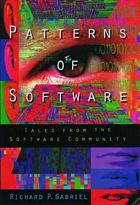
|
FreeComputerBooks.com
Links to Free Computer, Mathematics, Technical Books all over the World
|
|
- Title: Patterns of Software: Tales from the Software Community
- Author(s) Richard P. Gabriel
- Publisher: Oxford University Press, USA; eBook (Creative Commons Licensed)
- License(s): Creative Commons License (CC)
- Hardcover/Paperback: 256 pages
- eBook: PDF (239 pages, 1.2 MB)
- Language: English
- ISBN-10/ASIN: 0195121236/B003TJ9FGE
- ISBN-13: 978-0195121230
- Share This:

|
In our homes, our schools, and our businesses, computers play an ever-increasing role. But while most of us today can work a computer - albeit with the help of the ever-present computer software manual - we know little about what goes on inside the box and virtually nothing about software design or the world of computer programming.
In Patterns of Software, the respected software pioneer and computer scientist, Richard Gabriel, gives us an informative inside look at the world of software design and computer programming and the business that surrounds them. In this wide-ranging volume, Gabriel discusses such topics as what makes a successful programming language, how the rest of the world looks at and responds to the work of computer scientists, how he first became involved in computer programming and software development, what makes a successful software business, and why his own company, Lucid, failed in 1994, ten years after its inception.
Although computer scientists and software entrepreneurs will get much out of this book, the essays are accessible to everyone and will intrigue anyone curious about Silicon Valley, computer programming, or the world of high technology.
About the Authors- N/A
- Software Design and Patterns
- Software Engineering Principles and Practices
- Object-Oriented Analysis, Design and Programming (OOD/OOP)

- Patterns of Software: Tales from the Software Community (Richard P. Gabriel)
- The Mirror Site (1) - PDF
-
 Software Architecture Patterns (Mark Richards)
Software Architecture Patterns (Mark Richards)
This book takes a deep dive into many common software architecture patterns. Each pattern includes a full explanation of how it works, explains the pattern's benefits and considerations, and describes the circumstances and conditions it was designed to.
-
 Software Design for Flexibility (Chris Hanson, et al.)
Software Design for Flexibility (Chris Hanson, et al.)
This book describes techniques they have found effective--over their combined 100-plus years of programming experience--that will help programmers avoid programming themselves into corners.
-
 Domain-Driven Design Quickly (Abel Avram, et al)
Domain-Driven Design Quickly (Abel Avram, et al)
This book is a short, quickly-readable summary and introduction to the fundamentals of Domain Driven Design (DDD), it does not introduce any new concepts; it attempts to concisely summarize the essence of what DDD is, drawing mostly the original book.
-
 The Fable of the User-Centered Designer (David Travis)
The Fable of the User-Centered Designer (David Travis)
User-centred design is ostensibly simple, yet when it comes to great user experiences many people do it incorrectly. After reading this book, you'll understand the framework of user-centred design and know how to apply it to your own design project.
-
 Data-Oriented Design (Richard Fabian)
Data-Oriented Design (Richard Fabian)
This book is a practical guide for serious game developers. It is for game developers working to create triple A titles across multiple platforms, for independent developers trying to get the most out of their chosen target hardware, in fact for anyone who develops cutting edge software in restrictive hardware.
-
 Patterns of Enterprise Application Architecture (Martin Fowler)
Patterns of Enterprise Application Architecture (Martin Fowler)
This book is written in direct response to the stiff challenges that face enterprise application developers. It is an indispensable handbook of solutions that are applicable to any enterprise application platform.
-
 Composing Software: Functional and Object Composition
Composing Software: Functional and Object Composition
All software design is composition: the act of breaking complex problems down into smaller problems and composing those solutions. Most developers have a limited understanding of compositional techniques. It's time for that to change.





